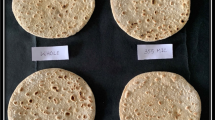Abstract
Wheat flour used in Turkish noodle (erişte) production was replaced with wheat germ (0, 10, 20 and 30 %) and β-glucan (0 and 4 %). Noodle samples were analyzed for their moisture, ash, protein, fat, mineral contents, color values and sensory properties. Cooking properties as volume increase (VI), weight increase (WI) and cooking loss (CL) were also determined. Wheat germ increased the ash, protein, fat and mineral contents of the noodles. β-glucan had an improving effect especially on Ca, Fe, Mg and P contents of noodle samples. While wheat germ raised VI values of the noodle, β-glucan had a negative effect on VI. The CL of noodle samples varied between 5.8 % and 7.3 %. Decreasing sensory scores obtained at high level of wheat germ with and without β-glucan. The present results showed that wheat germ and β-glucan have a good potential for increasing nutritional quality of noodle.


Similar content being viewed by others

References
AACC (1990) Approved methods of the American association of cereal chemists, 8th edn. AACC, St Paul
Akıllıoğlu HG, Yalçın E (2010) Some quality characteristics and nutritional properties of traditional egg pasta (noodle). Food Sci Biotechnol 19(2):417–424
Amado R, Arrigoni E (1992) Nutritive and functional properties of wheat germ. Int Food Ingredients 4:30–34
Arshad MU, Anjum FM, Zahoor T (2007) Nutritional assessment of cookies supplemented with defatted wheat germ. Food Chem 102:123–128
Bacic A, Stone BA (1981) Chemistry and organisation of aleurone cell wall components from wheat and barley. Aust J Plant Physiol 8:475–495
Bilgiçli N (2009) Effect of buckwheat flour on cooking quality and some chemical, antinutritional and sensory properties of noodle, Turkish noodle. Int J Food Sci Nutr 60(S4):70–80
Bilgiçli N, Elgün A, Herken EN, Türker S, Ertaş N, Ibanoğlu Ş (2006) Effect of wheat germ/bran addition on the chemical, nutritional and sensory quality of tarhana, a fermented wheat flour-yoghurt product. J Food Eng 77:680–686
Bilgiçli N, Demir MK, Ertaş N, Herken EN (2011) Effect of gluten and emulsifier on some properties of noodle prepared with legume flours. Int J Food Sci Nutr 62(1):63–70
Brennan CS, Clearly LJ (2005) The potential use of cereal (1 3, 1 4)-β-D-glucans as functional food ingredients. J Cereal Sci 42:1–13
Bubert H, Hagenah WD (1987) Detection and measurement. In: Boumans PWJM (ed) Inductively coupled plasma emission spectroscopy. Wiley, New York, pp 536–567
Chillo S, Laverse J, Falcone PM, Del Nobile MA (2008) Quality of spaghetti inbase amaranthus wholemeal flour added with quinoa, broad bean and chickpea. J Food Eng 84:101–107
Chillo S, Ranawana DV, Henry CJK (2011) Effect of two β-glucan concentrates on vitro glycaemic impact and cooking quality of spaghetti. LWT-Food Sci Technol 44:940–948
Chong LC, Aziah AAN (2010) Effects of banana flour and b-glucan on the nutritional and sensory evaluation of noodles. Food Chem 119:34–40
Eyidemir E (2006) Kayısı çekirdeği ilavesinin noodlenin bazı kalite kriterlerine etkisi. Inönü University, Food Engineering Department, Ms. Thesis, Turkey
Gallegos-Infante JA, Rocha-Guzman NE, Gonzalez-Laredo RF, Ochoa-Martínez LA, Corzo N, Bello-Perez LA, Medina-Torres L, Peralta-Alvarez LE (2010) Quality of spaghetti pasta containing Mexican common bean flour (Phaseolus vulgaris L.). Food Chem 119:1544–1549
Ge Y, Sun A, Ni Y, Chai T (2001) Study and development of defatted wheat germ nutritive noodle. Eur Food Res Technol 212:344–348
Izydorczyk MS, Biliaderis CG (1995) Cereal arabinoxylans: advances in structure and physicochemical properties. Carbohydr Polym 28:33–48
Karadeniz D (2007) Farklı besinsel lif kaynaklarının ve hidrokolloidlerin noodle üretiminde kullanımı, Ondokuz Mayıs University, Food Engineering Department, Ms. Thesis, Turkey
Karppinen S, Liukkonen K, Aura A, Forssell P, Poutanen K (2000) In vitro fermentation of polysaccharides of rye wheat and oat brans and inulin by human faecal bacteria. J Sci Food Agric 80:1469–1476
Knuckles BE, Hudson CA, Chiu MM, Sayre RN (1997) Effect of β-glucan barley fractions in high-fiber bread and pasta. Cereal Food World 42(22):94–99
Oh NH, Seib PA, Chung DS (1985) Noodles III. Effects of processing variables on quality characteristics of dry noodle. Cereal Chem 62:437–440
Özkaya B, Özkaya H, Büyükikiz E (2001) The cooking properties of, Eriste (Turkish noodle) produced by traditional methods. Getreide Mehl und Brot 55(2):120–125
Pagani MA, De Noni I, Resmini P, Pellegrino L (1986) Processing and heat damage of dry pasta. Tec Molitoria 47:345–361
Pınarlı İ, İbanoğlu Ş, Öner MD (2004) Effect of storage on selected properties of macaroni enriched with wheat germ. J Food Eng 64:249–256
Rayas-Duarte P, Mock CM, Satterlee LD (1996) Quality of spaghetti containing buckwheat, amaranth, and lupin flours. Cereal Chem 73:381–387
Resmini P, Pagani MA (1983) Ultrastructure studies of pasta. Food Microstruct 2:1
Shurpaleker SR, Haridas Rao P (1977) Wheat germ. In: Chichester CO, editor. Advances Food Research. New York : Academic Press, Vol. 23, 188–303
Sidhu JS, Kabir Y, Huffman FG (2007) Functional foods from cereal grains. Int J Food Prop 10(2):231–244
Yokoyama WH, Hudson CA, Knuckles BE, Chiu MM, Sayre RN, Turnland JR, Schneeman BO (1997) Effect of barley β-glucan in durum wheat pasta on human glycaemic response. Cereal Chem 74:293–296
Zhu KX, Zhou HM, Qian HF (2006) Proteins extracted from defatted wheat germ: nutritional and structural properties. Cereal Chem 83(1):69–75
Author information
Authors and Affiliations
Corresponding author
Additional information
Research highlights
1. Wheat germ (0, 10, 20 and 30 %) and β-glucan (0 and 4 %) were used in noodle formulation.
2. Wheat germ increased the ash, protein, fat and mineral contents of the noodles.
3. β-glucan especially improved Ca, Fe, Mg and P contents.
4. High level of wheat germ with and without β-glucan decreased sensory scores.
5. Wheat germ and β-glucan have a good potential for increasing nutritional quality of noodle.
Rights and permissions
About this article
Cite this article
Aktaş, K., Bilgiçli, N. & Levent, H. Influence of wheat germ and β-glucan on some chemical and sensory properties of Turkish noodle. J Food Sci Technol 52, 6055–6060 (2015). https://doi.org/10.1007/s13197-014-1677-z
Revised:
Accepted:
Published:
Issue Date:
DOI: https://doi.org/10.1007/s13197-014-1677-z


